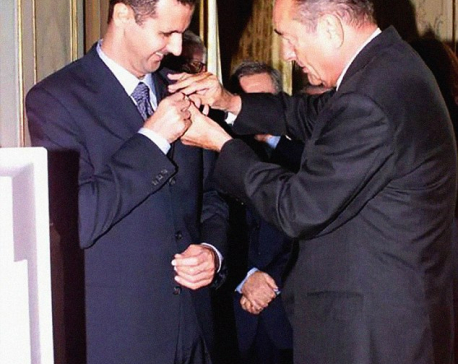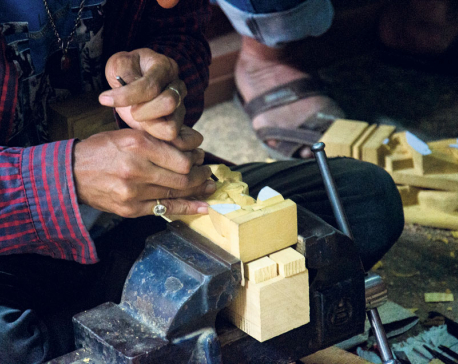
OR
live it up
Attractive wall paintings, artistic corners, and beautifully displayed sculptures make Srijana College of Fine Arts look like an imaginary world. A world created by extraordinary artists very different from the real one.
In one of the classrooms, students could be seen meticulously sculpting different figures and shapes with wet clay. While some had successfully crafted huge eyes and ears, others were struggling to give shape to their undefined piece. The exiting environment in this unusual classroom made us inquisitive to know more about them.
Education in arts
Most students this scribe spoke to said they were passionate about their field of study. They claim it’s because learning art is fun and very creatively stimulating as well. “I am addicted to making sculptures like smokers are addicted to cigarettes,” says Bishal Sara Magar, a third year Bachelors student at Srijana College of Fine Arts in Lazimpat, Kathmandu. “I crave for the smell of wet clay. And my fingers need to sculpt a piece of art each day,” he added drawing a very unusual parallel. But an uncommon conversation such as this was to be expected from a place that is filled with creative geniuses.
It would not be wrong to say that students and teachers there lived for art, spoke art and even greeted one another in an artistic way. Those specializing in sculpture making usually have their hands coated in clay. Hence, they greet one another not with a handshake but by bumping their fists together. The number of students specializing in sculpture making however seemed to be very less.
“There are about 14 students in this college who are specializing in sculpture making in their bachelor level,” says Sujin Shrestha, a first year student. “Our teacher says you need to be brave to take up sculpture making academically. And I totally agree with him,” he adds.
According to him, while painting, sketching and other forms of art could be done anywhere, sculpture making needed you to be fixed and focused in one place for hours. Paintings and sketching are also the more widely accepted form of art in Nepal having great commercial value and appeal. But sculpture making is yet to be recognized and appreciated by the masses. Yet the student’s passion and skills drive them to excel in this field. These students aim to bring about a revolution in sculpture making and make Nepal proud of its artists.
Unique interests
Each student specializing in sculpture making had his/her own unique interest and talent. “I am more inclined towards making realistic sculptures. People say I am good at it,” says Shrestha, another first year student at the same institute. Shrestha was known among his juniors for his ability to make natural and fine sculptures.
Bishal Sara Magar, on the other hand, does not like copying. “My sculptures are made out of imaginary characters. I have a style slightly different from others because I make semi realistic pieces of art,” he says. Magar likes making fantasy creatures that often look weird and out of the world.
Their artistic journey
The students also spoke to us about their artistic journey that was as interesting as their beautifully crafted pieces of clay. While some discovered their talent in sculpture making after joining this institute, others had to fight with their family to get here. “After completing my Bachelor in Education, I realized I did not like the subject,” says Hariram Adhikari, a recent graduate from Srijana College of Fine Arts.
“I came to Kathmandu to pursue art. Coming from a small town in Gulmi, I thought studying art meant studying sketching,” he adds claiming that he only realized his passion for sculpture making after joining this college. His family was not very happy with this choice but this is what he really wanted to do.
Magar was previously a science student. He came to Kathamndu to further his studies in the field of applied science. “One day I went to Kathmandu University and looked at all the fantastic art made by the students there. That made me want to study art,” says Magar.
Way to go
One thing common about all students we spoke to at this academy was that they enjoyed art and desired to be prominent figures in this field. “I plan to organize a solo exhibition displaying all my artwork before I complete my bachelors,” says Sujin Shrestha.
These skilled students had great expectations and were determined in proving to the world that building a successful career in sculpture making is possible. “I feel there are ample opportunities for those who want to pursue sculpture making academically in Nepal. I get so many commercial orders every single day. People want to work with you if you are skilled and you know your technique. This form of art has a bright future,” says an optimistic Adhikari.
Magar’s style is slightly different from the others and he wants to make his own unique contribution to the field of sculpture making and make a space for Nepali artists in the global arena. “I understand we have big dreams but they are not impossible to achieve,” he concludes.
Talking with the beginners
Obviously not all art students at the academy loved sculpture making. High school students had sculpture making classes twice a week and they were still getting equipped with the basic techniques. While some high school students seemed certain about their choice of subject, others were figuring them out. “I like sculpture making. It is a new thing for me and it’s extremely interesting as well. But I want to pursue Fashion Designing in my bachelors,” says Ditsha Shrestha, who is studying Fine Arts in her 12th grade. Her classmate, Kritika Shrestha, on the other hand, is uncertain about her further course of study.
Dipesh Maharjan, who is currently in grade 12, was confident about pursuing Bachelors in Fine Arts with specialization in sculpture making. “I want to specialize in sculpture making because I like making traditional sculptures. Nepal has a very rich and artistic heritage. My aim is to preserve that for the future generation,” he states.





You May Like This

Bashar al Assad hands back Legion d'Honneur medal as he calls the French 'slaves of the US' after missile attack
SYRIA, April 21: Syrian dictator Bashar al-Assad has sent a prestigious French award back in the post - saying he... Read More...

The hands that feed (photo feature)
KATHMANDU: As the famous adage goes: you can’t climb the ladder of success with your hands in your pockets. Calloused... Read More...

Terror at hands
By the time I held the ‘drill purpose’ SLR in my hands, all things military had stopped causing any excitement Read More...




Just In
- MoHP cautions docs working in govt hospitals not to work in private ones
- Over 400,000 tourists visited Mustang by road last year
- 19 hydropower projects to be showcased at investment summit
- Global oil and gold prices surge as Israel retaliates against Iran
- Sajha Yatayat cancels CEO appointment process for lack of candidates
- Govt padlocks Nepal Scouts’ property illegally occupied by NC lawmaker Deepak Khadka
- FWEAN meets with President Paudel to solicit support for women entrepreneurship
- Koshi provincial assembly passes resolution motion calling for special session by majority votes







_20220508065243.jpg)






Leave A Comment